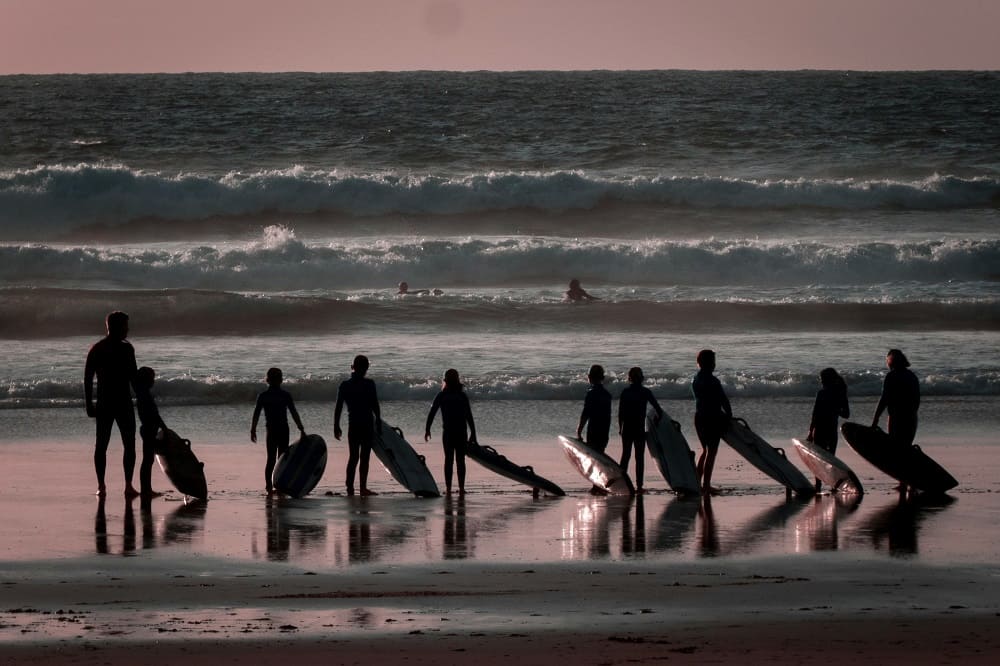Surfing isn’t just a sport; it’s a lifestyle and a passion that transcends generations. Introducing children to the joy of riding waves at a young age not only instills a love for the ocean but also fosters confidence, resilience, and a deep appreciation for nature. In this guide, we’ll explore the essential steps to help kids catch their first wave safely and joyfully.
Choosing the Right Surfboard
Selecting the appropriate surfboard for your child is a crucial step in ensuring their safety and enjoyment while learning to surf. Consideration of factors such as size, weight, and skill level is essential to choose the most suitable board. A board that is too large or heavy can be difficult for a child to maneuver, while one that is too small may compromise their stability and control in the water. Additionally, the type of surfboard—whether soft-top or hard-top—can impact a child’s surfing experience. Soft-top boards are often recommended for beginners due to their buoyancy and forgiving nature, providing a stable platform for learning the basics of paddling and riding waves. Conversely, hard-top boards offer greater maneuverability and performance but may be more challenging for young surfers to master. Ultimately, selecting the right surfboard for your child involves finding a balance between stability, maneuverability, and suitability for their skill level.
Safety Precautions
Ensuring the safety of children while they learn to surf is paramount. Proper safety gear, including a well-fitted leash and a comfortable wetsuit, is essential to protect against potential injuries in the water. Additionally, educating children about ocean safety is crucial to help them understand and mitigate risks while surfing. This includes teaching them how to identify rip currents, recognize hazards such as rocks and marine life, and communicate effectively with lifeguards or other surfers if assistance is needed. Establishing clear guidelines and boundaries for surfing activities, such as staying within designated areas and avoiding crowded or dangerous conditions, can further reduce the risk of accidents or emergencies. By prioritizing safety and providing children with the necessary knowledge and equipment, parents can ensure a positive and enjoyable surfing experience for their young ones.
Finding the Right Surfing Spot
Choosing an appropriate surfing location is essential for children to feel comfortable and confident while learning to surf. Opting for beaches with calm, shallow waters and gentle waves can provide an ideal environment for beginners to practice their skills. Such beaches typically have sandy bottoms and gradual slopes, allowing children to wade into the water safely and practice paddling and balancing on their boards without the fear of strong currents or deep waters. Additionally, selecting beginner-friendly beaches with designated surfing areas and lifeguard supervision can offer added peace of mind for parents and children alike. By finding the right surfing spot, parents can create a supportive and nurturing environment for their children to develop their surfing skills and build confidence in the water.
Basic Surfing Techniques
Teaching children the fundamentals of surfing involves introducing them to basic techniques such as paddling, positioning on the board, and riding waves. Starting with paddling exercises on land can help children familiarize themselves with the motions and build strength in their arms and shoulders before venturing into the water. Once in the water, parents can guide children through the process of paddling out to the lineup, finding the right position on their boards, and catching waves. Emphasizing proper body positioning, balance, and timing is essential to help children stay stable on their boards and ride waves safely and confidently. By breaking down the basic surfing techniques into manageable steps and providing hands-on guidance and encouragement, parents can empower their children to progress and develop their skills at their own pace.
Patience and Encouragement
Patience and encouragement are indispensable qualities for parents guiding their children through the process of learning to surf. Surfing can be challenging, especially for beginners, and it’s natural for children to experience frustration, setbacks, and moments of doubt along the way. Therefore, it’s essential for parents to approach the learning process with patience and understanding, recognizing that progress takes time and that each child learns at their own pace. Rather than focusing solely on achieving specific outcomes or milestones, parents should prioritize the journey itself, emphasizing the value of effort, perseverance, and personal growth. By providing consistent encouragement, support, and reassurance, parents can help children stay motivated and resilient in the face of challenges. Celebrating small victories, offering words of praise and affirmation, and fostering a positive learning environment can inspire children to persevere through difficulties and maintain a positive attitude toward surfing and life in general.
Professional Instruction vs. DIY
While some parents may choose to teach their children to surf independently, enrolling kids in surf schools can offer numerous benefits. Professional instructors can provide expert guidance, personalized feedback, and a safe learning environment for children to develop their skills. However, for parents opting for a DIY approach, there are plenty of resources and tips available to facilitate teaching kids to surf at their own pace.
Building Confidence
Building confidence in children is a foundational aspect of introducing them to surfing. As they venture into the ocean, children may initially feel apprehensive or uncertain about their abilities to navigate the waves and stay balanced on their boards. Therefore, it’s essential for parents to create a supportive and encouraging environment that empowers children to overcome their fears and embrace the challenges of surfing. One effective strategy for building confidence is to start with small, manageable waves and gradually progress to larger ones as children gain experience and proficiency. By setting achievable goals and celebrating each success, no matter how small, parents can help children build confidence in their surfing abilities and develop a positive mindset toward learning and growth. Additionally, providing constructive feedback and encouragement, as well as acknowledging and validating their efforts and progress, can boost children’s self-esteem and belief in their capabilities. Ultimately, building confidence in children requires patience, positivity, and a commitment to nurturing their sense of self-assurance as they embark on their surfing journey.
Environmental Awareness
In addition to teaching kids how to surf, instill in them a sense of environmental responsibility and stewardship for the ocean. Educate children about marine conservation, emphasizing the importance of protecting marine life, reducing plastic pollution, and preserving coastal ecosystems. Encourage kids to develop a deep respect and appreciation for the natural world as they explore the ocean’s wonders.
Health and Fitness Benefits
Surfing offers a myriad of health and fitness benefits for children, promoting physical activity, cardiovascular health, and mental well-being. Paddling, balancing, and riding waves provide a full-body workout that strengthens muscles, improves coordination, and enhances overall fitness levels. Furthermore, spending time in nature and connecting with the ocean can reduce stress, anxiety, and promote a sense of peace and tranquility.
Parental Involvement
Parental involvement plays a crucial role in shaping children’s experiences and attitudes toward surfing. Whether cheering from the shore or joining their children in the water, parents have the opportunity to actively participate in their children’s surfing journey and strengthen their bond through shared experiences. Engaging in surfing activities together not only fosters a sense of camaraderie and connection but also provides valuable opportunities for communication, mutual support, and quality time spent together as a family. Additionally, parental involvement can serve as a source of inspiration and motivation for children, as they witness their parents’ enthusiasm, dedication, and love for the sport. By actively participating in their children’s surfing adventures, parents can lead by example, instilling important values such as perseverance, resilience, and a love for the outdoors. Ultimately, parental involvement in surfing is about more than just teaching children how to ride waves—it’s about fostering a lifelong passion for adventure, exploration, and connection with the ocean.
Surfing as a Lifelong Skill
Introducing children to surfing at a young age lays the foundation for a lifelong passion and appreciation for the ocean. As kids grow and develop their skills, surfing becomes more than just a hobby; it becomes a way of life—a source of joy, inspiration, and self-expression. Encourage children to continue their surfing journey into adulthood, exploring new beaches, honing their skills, and sharing their love for the ocean with future generations.
Community and Camaraderie
Surfing not only offers individual benefits but also fosters a sense of community and camaraderie among enthusiasts. Encourage children to join local surf clubs, attend community events, and connect with fellow surfers of all ages. Through shared experiences, friendships, and mutual support, kids can develop a sense of belonging and identity within the surfing community, enriching their lives both on and off the waves.
Overcoming Challenges
Surfing presents various challenges for children, from mastering the basics of paddling and balancing to navigating waves and currents. It’s natural for young surfers to encounter setbacks and frustrations along the way, but overcoming these challenges is an integral part of the learning process. Encouraging children to approach challenges with a positive attitude, resilience, and determination can help them build confidence and perseverance in the face of adversity. Emphasizing the importance of patience and practice, parents can reassure children that progress takes time and that every wipeout and mistake is an opportunity for growth and improvement. By providing ongoing support, encouragement, and guidance, parents can help their children overcome challenges and become more skilled and confident surfers over time.
Conclusion
Introducing kids to the joy of surfing is a rewarding and transformative experience that offers numerous physical, mental, and emotional benefits. By providing a supportive and encouraging environment, teaching essential skills, and fostering a love for the ocean, parents can help children embark on a lifelong journey of adventure, exploration, and self-discovery through surfing.
FAQs (Frequently Asked Questions)
Children as young as five or six years old can begin learning to surf with the proper supervision and safety precautions in place.
While basic swimming skills are recommended, children don’t need to be strong swimmers to start surfing. However, it’s essential to ensure they feel comfortable and confident in the water.
Parents should ensure children wear appropriate safety gear, including a leash and wetsuit, and teach them about ocean safety, including how to identify rip currents and communicate with lifeguards.
Most surf schools accept children of all ages, but it’s best to check with the specific school for any age restrictions or recommendations.
Parents can encourage reluctant children to try surfing by providing gentle encouragement, setting achievable goals, and emphasizing the fun and excitement of riding waves.

Luca is a professional surfer with a passion for riding waves. He’s spent years perfecting his technique and exploring the world’s best surf spots. When he’s not out on the water, Luca enjoys sharing his surfing insights and experiences through blog.

